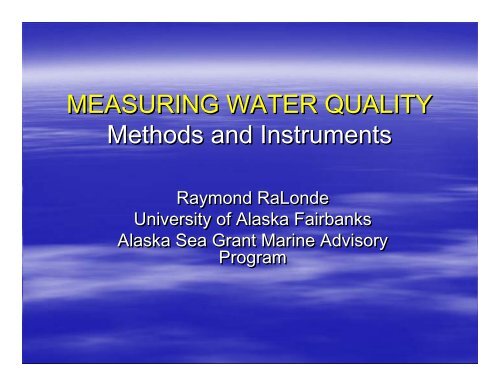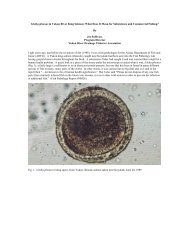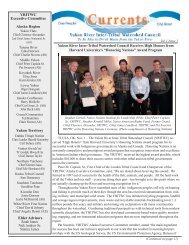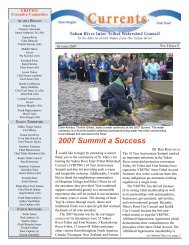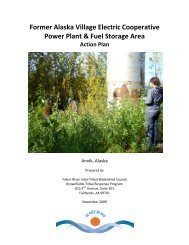Water Quality Monitoring Instruments and Methods
Water Quality Monitoring Instruments and Methods
Water Quality Monitoring Instruments and Methods
Create successful ePaper yourself
Turn your PDF publications into a flip-book with our unique Google optimized e-Paper software.
MEASURING WATER QUALITY<br />
<strong>Methods</strong> <strong>and</strong> <strong>Instruments</strong><br />
Raymond RaLonde<br />
University of Alaska Fairbanks<br />
Alaska Sea Grant Marine Advisory<br />
Program
WHAT TO MEASURE?<br />
• Weather<br />
– Often measured with water quality<br />
• Air Temp<br />
• Cloud cover<br />
– Weather station data<br />
• Precipitation<br />
• Air Pressure<br />
• Snow<br />
– Conductivity<br />
• Photography<br />
– Of monitoring locations<br />
– Habitat evaluation
WATER COLLECTION<br />
vANdORN$125.00
TEMPERATURE MONITORING<br />
Thermometers<br />
•Calibration thermometer<br />
•Nothing replaces a<br />
good thermometer<br />
– Accuracy ± 0.1 o<br />
• Max/Min<br />
– Always h<strong>and</strong>y<br />
• Electronic recording<br />
– YSI temperature probe<br />
– Require calibration
TEMPERATURE RECORDERS<br />
Electronic thermometers<br />
Suppliers<br />
Radio shack, Hannah,<br />
Aquatic Ecosystems<br />
• <strong>Water</strong>proof<br />
• Record Max/Min<br />
• Extension cords for outside<br />
• Cost $15.00-60.00<br />
• Accuracy 1 o C<br />
• Calibrate with thermometer
TEMPERATURE RECORDERS<br />
Temperature data loggers<br />
• Hanna<br />
• Hobo logger<br />
– Set timing period (sec-days)<br />
• Set for every 6 hours<br />
• Deploy at top of lantern net to<br />
account for tide <strong>and</strong> solar influences<br />
– 21,580 measurements<br />
– Accuracy 0.02 o<br />
– Logger cost $110.00 each<br />
– Infrared base station $60.00<br />
• Boxcar Pro for Readout<br />
– One-timer purchase $95.00<br />
– Export data to Excel
HOBO DATA LOGGER<br />
DEPLOYMENT
HOBO DATA LOGGER<br />
Readout
TYPES OF SUSPENDED SOLIDS<br />
• Organic – Volatile (burn to ash)<br />
– Organic material was once living (e.g. plants)<br />
– Closer to the surface<br />
• Inorganic – (Does not burn to ash)<br />
– Example (finely ground rock)<br />
– Deeper in the water (heavier than organics)<br />
– Colloidal – Stays in suspension – May need a flocculent<br />
to settle the solids<br />
– Settleable – Settles with time
TURBIDITY IS NOT AS SIMPLE<br />
AS IT MAY SEEM<br />
• Need to consider the objectives of the<br />
measurement<br />
• Difference in particle composition<br />
– Organic or inorganic<br />
– Setteable or suspended<br />
• Degree of precision required for the monitoring<br />
project<br />
– <strong>Monitoring</strong> or litigation requirement
TURBIDITY TESTING METHODS<br />
• Turbidity measures the actual quality <strong>and</strong><br />
quantity of suspended solids in the water<br />
– JTU (Jackson Turbidity Units)<br />
• Measurement of transmission of light<br />
– NTU (Nephelometric Turbidity Units)<br />
• Measurement of dispersal of light<br />
– Secchi Disk<br />
• Measurement of light penetration<br />
– Settling cones<br />
• Heavy inorganic solids
JTU <strong>and</strong> NTU<br />
Transmission vs. Dispersion<br />
JTU<br />
Light<br />
receiver<br />
NTU<br />
Light<br />
receiver<br />
Light<br />
Light<br />
<strong>Water</strong> sample<br />
<strong>Water</strong> sample
TURBIDITY METERS<br />
• Required for accurate<br />
measurement<br />
• Required for<br />
regulatory purpose $700.00<br />
$2,775.00
SETTLEABLE SOLIDS AND<br />
THE SECCHI DISK<br />
SIMPLICITY AT ITS BEST<br />
Settling Cones<br />
One hour<br />
Measure<br />
the volume<br />
Secchi disk<br />
<strong>Water</strong> surface<br />
Lower the secchi<br />
into the water until<br />
it disappears<br />
Record apparent color<br />
Yellow<br />
Gray<br />
Blue<br />
Green
CONDUCTIVITY<br />
• Ionic content of water – Charged particles<br />
–Ca + , Cu + , Hg + , Mg +<br />
• Measured by ability of water to carry an electrical<br />
current<br />
• The reverse of resistance<br />
• Higher ionic content the better the conductance<br />
• Expressed as microhms/cm of conductance<br />
• Related to pH - Generally high conductivity<br />
means higher pH
CONDUCTIVITY<br />
• Directly related to (TDS)<br />
total dissolved solids<br />
–Ca, , Mg, Na, K, CO 3 ,<br />
SO 4 , Cl<br />
• Moderate levels<br />
improve productivity<br />
• Ease osmoregulatory<br />
stress at higher<br />
conductivity<br />
TDS mg/L<br />
160<br />
140<br />
120<br />
100<br />
80<br />
60<br />
40<br />
20<br />
0<br />
0 100 200 300<br />
Conductivity
CONDUCTIVITY<br />
• Hannah conductivity, PH, TDS meter, Redox<br />
• Conductivity in relation to total dissolved solids<br />
– Coastal S.E. Alaska low<br />
– Interior streams relatively high<br />
– Seawater very high<br />
• Dissolved solids <strong>and</strong> salinity<br />
$129.00<br />
– Less then 1000 mg/L - Freshwater<br />
– 1,000-3,000 mg/L - Slightly saline<br />
– 3,000-10,000 mg/L - Moderately saline<br />
– 10,000-35,000 mg/l - Very saline (Ocean concentrations)
SALINITY<br />
• Ocean concentration ~ 36 ppt<br />
– Affected by temperature <strong>and</strong> pressure<br />
– Warmer <strong>and</strong> deeper water more saline<br />
• Salinity nearshore affected by freshwater,<br />
• Estuaries vary from 0-360<br />
ppt<br />
• Measure salinity to aid in locating source of<br />
pollution<br />
• Tolerance to high <strong>and</strong> low salinities vary by<br />
species
SALINITY RECORDERS<br />
Hydrometers<br />
• Least expensive<br />
– $30.00 to 100.00<br />
– Compensate for<br />
temperature<br />
• Accuracy ± 1.5 ppt
SALINITY RECORDERS<br />
• Conductivity meters<br />
– Expensive<br />
– Hundreds to thous<strong>and</strong>s<br />
– Adjust for temperature<br />
• YSI Meter salinity meters<br />
– Expensive ($800.00 +)<br />
– Easy to use<br />
– Record temperature also<br />
– Record at different depths
SALINITY RECORDERS<br />
Refractometers<br />
• Very simple to use<br />
• Portable<br />
• Ask for temperature<br />
compensation model<br />
• $45.00-$205.00<br />
$205.00
CHLORIDE<br />
• Generally very low is<br />
freshwater (ave 8.3<br />
ppm)<br />
• Primarily component in<br />
salt water (19.3 ppt)<br />
– 19,300 ppm<br />
• Test strips (30-600<br />
ppm)<br />
• Titration (drop by drop<br />
5-200 ppm)<br />
• Colorimeter (0 to 20<br />
ppm)<br />
$900.00<br />
$33.00/40 tests<br />
$74.00/100 tests
pH<br />
• Measure of “hydrogen<br />
power”<br />
• Often referred to as<br />
– Acidic or Alkaline<br />
• Living organisms must<br />
function with narrow<br />
range of pH<br />
– 6.5-8.5<br />
pH = -log H +<br />
pH scale 1-14<br />
Lemon juice -2<br />
Orange juice-3<br />
Sodium<br />
bicarbonate-8<br />
Ammonia-10
WHAT DOES PH MEAN<br />
WITH THE NORMAL RANGE MEAN?<br />
• Higher pH makes ammonia compounds<br />
more toxic<br />
• Lower pH enable dissolving of heavy metals<br />
if present in the water<br />
• Higher pH increase respiratory efficiency<br />
• Lower pH generally indicated lower mineral<br />
concentrations (TDS)<br />
• Ph affects rates of biochemical reactions
• High pH<br />
• High particulate organic<br />
matter concentration<br />
• High suspended<br />
SUSPENDED<br />
sediment load<br />
SEDIMENT<br />
• <strong>Water</strong> circulation high<br />
PHASE<br />
PARITIONING<br />
TRIANGLE<br />
DISSOLVED<br />
IN WATER<br />
• Low pH<br />
• Low particulate organic<br />
matter concentration<br />
• Low suspended<br />
sediment load<br />
• High dissolved organic<br />
matter concentration<br />
BOTTOM<br />
SEDIMENT<br />
• High pH<br />
• High particulate organic<br />
matter concentration
WHAT ARE THE METALS?<br />
• Abundant metals – e.g. aluminum, iron<br />
• Rare metals – mercury, cadmium, silver<br />
• Trace metals – “micronutients” – copper,<br />
zinc, chromium
SOURCES<br />
• Chemical weathering<br />
• Runoff sediments<br />
• Atmospheric deposition<br />
• Chemicals – antifouling agents, metal from<br />
pipes<br />
• Oxidation of acid sulfate soils<br />
• Mining <strong>and</strong> l<strong>and</strong> disturbance<br />
• Waste discharge
• Low pH<br />
DISSOLVED METALS<br />
PREDOMINATE WITH<br />
– Solubility of metal hydroxides (Ca(OH)2, Mg(OH)2,<br />
Fe(OH)2, Al(OH)3) increase as pH drops<br />
– Adsorption capacity on solid surfaces<br />
–H + from the acid competes with metals for attachment<br />
sites on organic molecules<br />
• Low particulate matter<br />
• High levels of dissolved organic matter
METAL PARTITIONING<br />
• Partitioning refers to the transfer of metal<br />
(including contaminants such as heavy<br />
metals) between different phases <strong>and</strong><br />
biological components (benthos <strong>and</strong><br />
plankton) in natural waters.<br />
•Soluble – Most bioavailable<br />
•Suspended – Bonded in some form<br />
•Settlable – In the sediment
TYPES OF METAL<br />
PARTITIONING<br />
• Adsorption – Adherence of a substance to<br />
another in which is contacts<br />
– Most common process since metals have an<br />
attraction for iron, particulate organic matter <strong>and</strong> clays<br />
• Complexation – Complex bonding process<br />
where ions or molecules bond to a central<br />
charged particle, usually a metal.<br />
– Remain in solution<br />
• Precipitation - A chemical reaction where a<br />
soluble substance become heavy enough to<br />
settle out (precipitate)
ORGANIC ADSORPTION<br />
• Metal adheres directly to a<br />
clay or organic particle<br />
– Heavy it sinks<br />
– May stay in solution<br />
Cu Zn<br />
Clay particle<br />
Zn<br />
Cu Cu<br />
Zn
ORGANIC MATERIAL EFFECT<br />
% Copper attached<br />
120<br />
100<br />
80<br />
60<br />
40<br />
20<br />
0<br />
Deep<br />
Surface<br />
0 1 2 3 4 5 6 7<br />
% Carbon (Organic material)
Mercury<br />
ALASKAN TESTING<br />
RESULTS<br />
(Alaska Dept Environmental Conservation)<br />
Some concern about bioaccumulation<br />
in spawning <strong>and</strong> rearing streams<br />
over time.
SUMMARY<br />
• Testing of heavy metals requires<br />
laboratory services<br />
• Proper sampling is essential<br />
• The affects of pH <strong>and</strong> salinity cause by<br />
freshwater influences are profound<br />
• Heavy metals are cumulative, must look at<br />
the long term<br />
• Organism tolerance <strong>and</strong> bioaccumulation<br />
are extremely variable by species
NITROGENOUS COMPOUNDS<br />
• Ammonia (NH 3 ) – Byproduct of protein digestion<br />
with deamination of amino acids in the protein<br />
– Directly lethal to aquatic organisms<br />
• Nitrite (NO 3 ) – Nitrosomonas bacteria <strong>and</strong> oxygen<br />
– Generally in small quantitie<br />
• Nitrate (NO 4 )- Nitrobacter <strong>and</strong> oxygen more<br />
abundant than nitrite or ammonia if oxygen is<br />
available
THE END<br />
• The end of this program is the beginning of<br />
planning<br />
• You project may encompass part, all, or<br />
other measurements that presented here<br />
• We are here to provide personal advice <strong>and</strong><br />
additional information in the presentations to<br />
follow<br />
• Do not expect to get a QAPP finished here,<br />
but you will have the basics to followup


